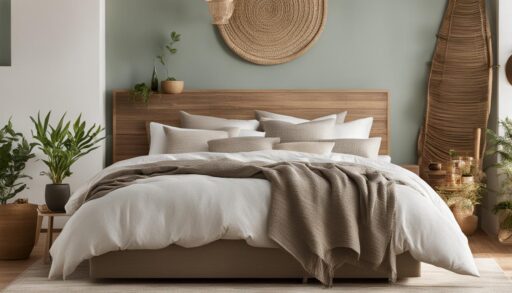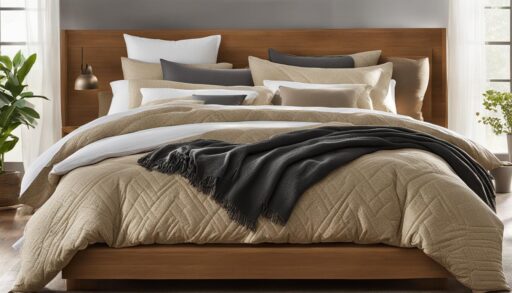When it comes to donating bedding, there are several top-rated charities and organizations in the United States that accept these donations. By donating your bedding, you can help provide comfort and warmth to those in need. Let’s explore where you can donate your bedding today.
Key Takeaways:
- Donate your bedding to reputable organizations like The Salvation Army, Habitat for Humanity, and Goodwill
- Contact local homeless shelters and women’s shelters to inquire about their specific bedding donation needs
- Consider donating bedding to animal shelters to provide comfort for furry friends
- Use online platforms and community drives/events as alternative donation options
- Recycle bedding that is no longer suitable for donation at local recycling centers
The Salvation Army: Providing Support and Rehabilitation
The Salvation Army is a well-known charitable organization that accepts bedding donations. They have thrift stores across the United States where you can drop off your gently used bedding items. The Salvation Army uses the proceeds from their thrift stores to fund their Adult Rehabilitation Centers, providing help and hope to those struggling with drug and alcohol addiction. Donating bedding to The Salvation Army is a great way to make a positive impact in your community.
Donation Guidelines
When donating bedding to The Salvation Army, it’s important to follow their guidelines to ensure that your donation can be utilized effectively. Here are some general tips to keep in mind:
- Ensure that your bedding is clean and in good condition. The Salvation Army cannot accept items that are torn, stained, or heavily worn.
- Check with your local Salvation Army thrift store for specific bedding items they accept. They may have restrictions on certain types of bedding, such as waterbeds or electric blankets.
- If you have multiple bedding items to donate, consider bundling them together with a ribbon or tie to keep them organized.
- When dropping off your donation, inquire about a tax receipt if you would like to claim a deduction for your charitable contribution.
By following these guidelines, you can ensure that your bedding donation to The Salvation Army will be put to good use, providing support and rehabilitation to those in need. So, gather your gently used bedding and locate a Salvation Army thrift store near you to make your donation today.
| Thrift Store Location | Contact Information |
|---|---|
| 123 Main Street | (123) 456-7890 |
| 456 Elm Avenue | (987) 654-3210 |
| 789 Oak Road | (555) 123-4567 |
Local Bedding Donation Options
When it comes to donating your bedding, there are various local options available that allow you to support your community while making a positive impact. Consider the following local bedding donation options:
Habitat for Humanity
Habitat for Humanity is a well-known organization that aims to provide affordable housing to those in need. While their main focus is building homes, they also accept donations of furniture and household items, including bedding. Reach out to your local Habitat for Humanity chapter to inquire about their specific donation guidelines and how you can contribute to their mission of changing lives through housing.
Local Homeless Shelters
Many local homeless shelters accept donations of bedding to provide comfort and support to individuals experiencing homelessness. These shelters often have specific guidelines for donation drop-offs, so it’s best to contact them directly to inquire about their specific needs and donation process. Donating your bedding to a local homeless shelter is a direct way to make a difference in the lives of those in need in your community.
Women’s Shelters
Women’s shelters provide a safe haven for women and children escaping domestic violence. These shelters often rely on donations to provide essential items, including bedding, to those in need. Reach out to local women’s shelters in your area to find out if they accept bedding donations and how you can contribute to their mission of offering safety and support to survivors.
By donating your bedding to these local organizations, you are not only helping those in need but also playing a crucial role in building stronger and more supportive communities. Remember to reach out to each organization directly to inquire about their specific donation guidelines and any additional items they may accept.
Goodwill: Empowering Individuals Through Donations
If you’re looking to donate your used bedding and make a difference in your community, Goodwill is a nonprofit organization that you should consider. Goodwill’s mission is to empower individuals by providing job training and opportunities, and they accept a wide range of donations, including bedding.
Goodwill has donation centers and drop-off locations throughout the United States, making it convenient for you to donate your bedding. By donating to Goodwill, you are not only helping individuals in need but also supporting the organization’s efforts to create a more inclusive and equitable society.
When you donate your bedding to Goodwill, you can feel good knowing that it will be put to good use. Whether it’s providing comfort to someone in their job training program or being sold in their thrift stores to fund their mission, your donation has a positive impact.
Local Homeless Shelters: Providing Comfort and Support
When it comes to donating bedding, local homeless shelters play a crucial role in providing comfort and support to individuals experiencing homelessness. These shelters rely on the generosity of the community to help meet the basic needs of their residents, including bedding. By donating your bedding to a local homeless shelter, you can directly impact the lives of those in need in your community.
Before making your donation, it’s important to contact the shelter directly to inquire about their specific needs and donation process. Some shelters may have specific guidelines for donation drop-offs or certain types of bedding that they can accept. This ensures that your donation is used effectively and matches the shelter’s requirements.
Donating bedding to a local homeless shelter is a tangible way to make a difference. It provides individuals without a stable place to live with a comfortable and warm bed, promoting restful sleep and a sense of dignity. Your donation can bring comfort and a small sense of normalcy to those facing challenging circumstances.

Benefits of Donating Bedding to Homeless Shelters
- Provides comfort and warmth to individuals experiencing homelessness
- Promotes better sleep and overall well-being
- Supports the efforts of local shelters in helping those in need
- Offers a tangible way to make a positive impact in your community
“Donating bedding to a local homeless shelter is a direct way to make a difference in the lives of those in need in your community.”
Conclusion
Consider reaching out to local homeless shelters in your area to find out how you can donate your bedding and support their essential work. Your donation can provide comfort, warmth, and support to individuals experiencing homelessness, making a meaningful impact in their lives. Take action today and contribute to the vital mission of local homeless shelters.
Women’s Shelters: Offering Safety and Support
Women’s shelters provide a safe haven for women and children escaping domestic violence. These shelters often rely on donations to provide essential items, including bedding, to those in need. By donating your bedding to women’s shelters, you are helping to offer safety and support to survivors of domestic abuse.
When considering where to donate your bedding, reaching out to local women’s shelters is a great option. Many shelters have dedicated donation centers or drop-off locations where you can contribute your bedding. Contact the shelters in your area to inquire about their specific needs and donation guidelines.
Your donation of bedding to women’s shelters can make a significant difference in the lives of those who have experienced domestic violence. It provides them with the comfort and security they need as they rebuild their lives. By supporting women’s shelters, you are joining the fight against domestic abuse and helping to create a safer and more nurturing society for everyone.
The Impact of Your Donation
Your donation of bedding to women’s shelters can have a profound impact on the lives of survivors. It provides them with a sense of security, comfort, and warmth during a difficult time. By contributing to these shelters, you are helping to create a safe and supportive environment where survivors can heal and rebuild their lives.
| Benefits of Donating Bedding to Women’s Shelters | How Your Donation Helps |
|---|---|
| Provides survivors with a safe and comfortable place to rest | Offers a sense of security and stability |
| Helps shelters meet the basic needs of survivors | Allows shelters to allocate funds to other important resources and programs |
| Contributes to creating a nurturing and supportive environment | Empowers survivors in their journey towards healing and independence |
Donating your bedding to women’s shelters is a tangible way to show your support for survivors of domestic violence. It provides them with the comfort and safety they deserve as they rebuild their lives and work towards a brighter future.
Animal Shelters: Providing Comfort for Furry Friends
Animal shelters play a crucial role in providing care and shelter for abandoned and homeless animals. These shelters rely on donations from the community to meet the needs of their furry residents. One way you can contribute to their mission is by donating bedding to provide comfort and warmth for the animals. While some shelters may have specific guidelines for the types of bedding they can accept, many are grateful for clean and gently used bedding donations.
If you’re considering donating bedding to an animal shelter, it’s best to reach out to your local shelter directly to inquire about their specific needs and donation process. They may have designated donation centers where you can drop off your donations, or they may have specific items they are currently in need of. By connecting with the shelter directly, you can ensure that your donation will have the most impact in providing comfort to the animals.
| Animal Shelter | Location | Contact Information |
|---|---|---|
| Happy Tails Animal Shelter | 123 Main Street, Anytown, USA | Phone: 555-123-4567 Email: info@happytails.org |
| Paws and Whiskers Rescue | 456 Maple Avenue, Othertown, USA | Phone: 555-987-6543 Email: rescue@pawsandwhiskers.org |
Why Donate Bedding to Animal Shelters?
Donating bedding to animal shelters not only provides comfort and warmth for the animals but also helps alleviate some of the financial burden shelters face in providing for their residents. By donating bedding, you are assisting shelters in redirecting their resources to other areas of need, such as medical care, food, and facility maintenance.
Additionally, providing a cozy and comfortable environment for the animals can contribute to their overall well-being and reduce stress during their stay at the shelter. It can also make them more comfortable and appealing to potential adopters, increasing their chances of finding a loving forever home.
So, if you have gently used bedding that you no longer need, consider donating it to your local animal shelter. Your donation can make a significant difference in the lives of these furry friends as they await their forever homes.

Why Recycle Bedding?
Recycling bedding is not only good for the environment but also promotes sustainability. Here are a few reasons why recycling bedding is beneficial:
- Resource Conservation: Recycling bedding reduces the need for virgin materials, such as cotton and polyester, which require significant resources to produce. By recycling, these resources can be conserved for other purposes.
- Waste Reduction: Textile waste, including old bedding, contributes to the growing problem of landfill overcrowding. Recycling helps divert this waste from landfills, minimizing the negative impact on the environment.
- Energy and Water Savings: Recycling bedding requires less energy and water compared to the production of new textiles. By recycling, you help conserve these valuable resources.
- Economic Benefits: Recycling centers often process and sell recycled textiles, contributing to job creation and economic growth.
By choosing to recycle your bedding, you join the global effort to reduce waste, conserve resources, and create a more sustainable future for generations to come.
Community Drives and Events: Supporting Local Causes
If you want to support local causes and make a difference in your community, participating in community drives and events is a great option. These initiatives are often organized by local charities, schools, or community organizations with the aim of collecting bedding donations to help those in need.
Community drives and events provide a convenient way for you to donate your bedding and contribute to a worthy cause. By participating, you can ensure that your donations directly benefit individuals and families in your local area who may be experiencing difficult circumstances.
To find community drives and events near you, check your local community calendars, inquire with local charities, or reach out to schools and community organizations. These sources often have information about upcoming drives and events that focus on collecting bedding donations. By supporting these initiatives, you can play an active role in making a positive impact in your community.
Benefits of Participating in Community Drives and Events
Participating in community drives and events offers several benefits:
- Supporting local causes: By donating your bedding to community drives and events, you are directly supporting local causes that aim to improve the lives of individuals and families in your community.
- Making a tangible impact: Your donations can provide comfort and essential resources to those in need, making a tangible difference in their lives.
- Building community connections: Participating in community drives and events allows you to connect with like-minded individuals and organizations who are passionate about giving back.
- Creating awareness: These drives and events help raise awareness about the importance of supporting those in need, inspiring others to get involved and make a difference.
Whether it’s a local charity drive, a school-sponsored event, or a community-wide initiative, participating in community drives and events is a meaningful way to support local causes and make a positive impact in your community.
Conclusion
When it comes to donating bedding, there are numerous options available to you. From well-known organizations like The Salvation Army and Habitat for Humanity to local homeless shelters and women’s shelters, there are various places where you can make a positive impact in your community.
Consider your values and the causes that are important to you when deciding where to donate your bedding. Whether you choose to support charities that provide support and rehabilitation or focus on organizations that offer safety and support to those in need, your donation can bring comfort, warmth, and support to individuals and families.
Additionally, you can explore online platforms like Freecycle, Craigslist, and Facebook Marketplace to connect directly with recipients who are in need of bedding donations. Recycling centers also provide a sustainable option for responsibly disposing of old and worn-out bedding.
Take action today and make a difference. Donate your bedding to those in need and contribute to creating a better and more supportive community for everyone.
FAQ
Where can I donate bedding?
There are several options for donating bedding in the United States. You can donate to well-known organizations like The Salvation Army, Habitat for Humanity, and Goodwill. Additionally, local homeless shelters, women’s shelters, and animal shelters often accept bedding donations. Online platforms like Freecycle, Craigslist, and Facebook Marketplace can also connect you with individuals or organizations in need. Finally, consider recycling your bedding at a local recycling center.
What types of bedding can I donate?
Most organizations accept clean and gently used bedding items, such as sheets, blankets, pillows, and comforters. However, it’s best to check with the specific organization or shelter for any restrictions or guidelines they may have.
How do I find a donation center near me?
To find a donation center near you, you can use online resources like the websites of The Salvation Army, Habitat for Humanity, or Goodwill to locate their nearest thrift stores or drop-off locations. For other organizations, such as homeless shelters or women’s shelters, it’s recommended to contact them directly for information on their donation process and location.
Can I donate bedding that is no longer in good condition?
If your bedding is no longer suitable for donation due to wear and tear, it can still be recycled responsibly. Many recycling centers accept textiles, including bedding, for recycling. Look for local recycling centers or programs in your area that offer textile recycling.
How can I support local causes through bedding donations?
One way to support local causes is by participating in community drives and events that focus on collecting bedding donations. These events are often organized by local charities, schools, or community organizations and provide a convenient way to donate your bedding. Check your local community calendars or reach out to organizations in your area to find out about upcoming drives or events.





















